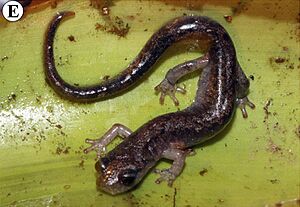Orange-tailed agile salamander facts for kids
Quick facts for kids Orange-tailed agile salamander |
|
|---|---|
 |
|
| Specimen from near Plan de Guadalupe | |
| Conservation status | |
| Scientific classification |
The orange-tailed agile salamander (Pseudoeurycea ruficauda) is a cool type of salamander. It belongs to a family called Plethodontidae. This special salamander only lives in one place: the Sierra Mazateca mountains in Mexico. These mountains are part of the Sierra Madre de Oaxaca range.
Its scientific name, ruficauda, comes from Latin words. "Rufous" means reddish, and "cauda" means tail. This name perfectly describes its reddish-orange tail! Its closest cousin is another salamander called P. jaguar.
What Does It Look Like?
This salamander isn't very big. It can grow up to about 45 millimeters (1.8 inches) long from its snout to its bottom. Its tail is usually a little shorter than its body.
The orange-tailed agile salamander has a fairly large head. Its eyes are big and stick out a bit. Its body is thin, and its legs are long. Its hands and feet are wide, with long, separate fingers and toes.
Its back is orange-tan with shiny, coppery-gold spots mixed with black. It has a stripe down its back that can be tan-yellow, orange, or reddish-brown. This stripe isn't always smooth and can sometimes be broken. The tail is orange with black spots and a bright, red-orange or yellow-orange tip.
Where Does It Live and How Can We Help?
The orange-tailed agile salamander lives in moist forests. These forests have a mix of pine and oak trees. You can find them high up in the mountains, between 2,235 and 2,290 meters (about 7,330 to 7,510 feet) above sea level.
These salamanders are arboreal, which means they like to live in trees. You might find them under the bark of fallen logs or hiding in plants that grow on other trees (called epiphytes). They also like to hide in cracks in rocks. Scientists believe that baby salamanders hatch directly from eggs, looking like tiny versions of the adults. This means they don't have a separate larval stage that lives in water.
Even though this salamander is common in the two places it's known to live, its home is shrinking. People are clearing the forest for small farms and cutting down trees for wood. Sadly, this salamander doesn't live in any protected areas right now. This makes it important to protect its habitat so it can continue to thrive!


